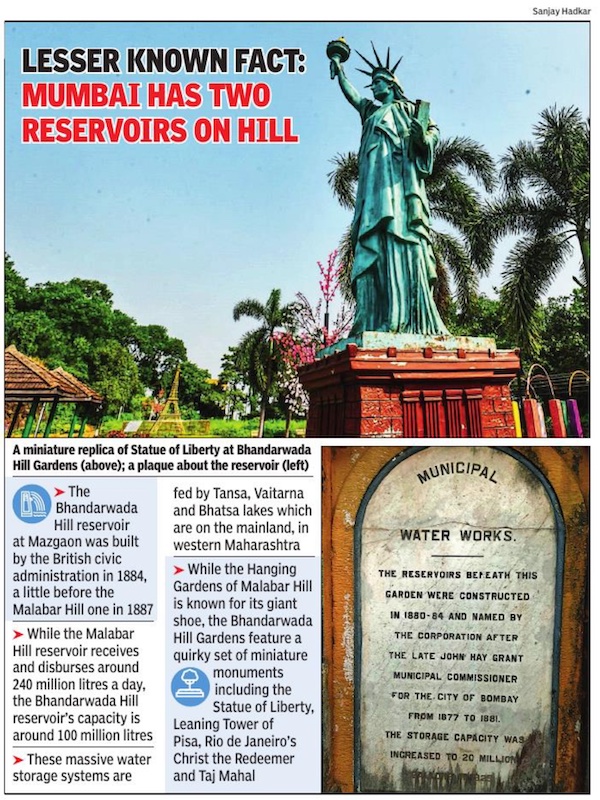Mumbai: water supply
This is a collection of articles archived for the excellence of their content. |
Waterworks
British-era reservoirs
Namita Devidayal, Oct 24, 2023: The Times of India

From: Namita Devidayal, Oct 24, 2023: The Times of India
In a city that is moving skywards, not too many know about the underground organs that service its needs - starting with water. The Hanging Gardensof Malabar Hill are currently in the spotlight because of the water reservoir that lies beneath. Mumbai's second major reservoir is also built on top of a hill with a 'hanging' garden, located in Mazgaon.
The Joseph Baptista Gardens, named after a local freedom fighter called 'Kaka Baptista', is a beautifully maintained 1.5 acre park with a children's play area, walking track and a magnificent view. While Hanging Gardens famously overlooks the western bay, the Mazgaon garden overlooks the eastern waterfront and its buzzy new freeway, with cranes punctuating the sky in the distance. Beneath the garden lies the Bhandarwada Hill reservoir from which water flows, through a mind-bogglingly complex network of underground pipes, into our taps.
Both reservoirs are intertwined with the city's history. Some time in the 1840s, an agitation on the shortage of drinking water by the "natives" catalyzed the British civic administration to seek water sources as far as 100km into the mainland. Before that, the residents relied on the wells and tanks within the island city, including "Byculla Ta-nk, Baboola Tank, and Mombadavee Tank". But with a growing population, these water bodies had started running dry or were brackish.
Commenting on the state of things, an 1845 government report states: "The natives were seen at the bottom of some of the wells trying to get a few lotas full to carry away ... It is rather extraordinary that hitherto no efforts have been made by the leading Natives of Bombay to increase the supply and improve the quality of the water in this island; but native apathy will do nothing till driven or excited by European energy..."
The English officials went about looking for suitable spots to create reservoirs, the two main criteria being height and surface area. The Mazgaon reservoir was built in 1884, a little before the Malabar Hill one in 1887. The British civic administration picked a couple of basalt rock hills which could house these vast storage tanks, namely Malabar Hill and Bhandarwada Hill. The Malabar Hill reservoir receives and disburses some 240 million litres per day. The Bhandarwada Hill reservoir capacity is 100 million litres, according to a hydraulic engineer in the municipal corporation. These massive water storage systems are fed by Tansa, Vaitarna and Bhatsa lakes which are on the mainland, in western Maharashtra. There are about 17 smaller reservoirs across the city and suburbs, which send water through some 650km of transmission mains, 32,000km of distribution mains and 3,200 km of service pipes.
The British government made an astute observation about Indians and water. "To a native of India, of whatever caste, water is as essential as air... With all classes, water is associated with the most indispensable and everyday functions of their being. They never speak of any place or country without reference to its quality or quantity of water; and, when sick, invariably talk of changing not the air, as we do, but the water."
While the Hanging Gardens is known for its giant shoe, the Bhandarwada Hill Gardens feature a quirky set of miniature monuments scattered across the well-manicured grass for those who may never get a chance to venture outside Mumbai, let alone fly to another continent. They can take a selfie pushing back the Leaning Tower of Pisa, or pose in front of the Statue of Liberty. Beyond the replica of the Taj Mahal stands Rio de Janeiro's famous Christ the Redeemer, silhouetted against the Mumbai docks.
Besides quenching the eastern Mumbai's thirst, the Mazgaon garden happens to be located in a fascinatingly cosmopolitan pocket and is a reminder of Mumbai's extraordinary layered histories. This area was once more posh than tony Malabar Hill and is still dotted with stunning old bungalows, suggesting that the fate of Mumbai's famed real estate keeps changing with the times. With Dockyard Road station on one side, the old Gamdevi temple next door, many Muslim dominated residential buildings, and the very Christian St Mary's School just down the road, Joseph Baptista Gardens and Reservoir is one of the jewels in Mumbai's crown.